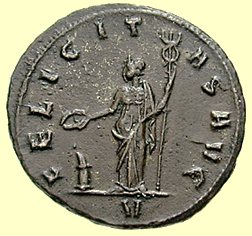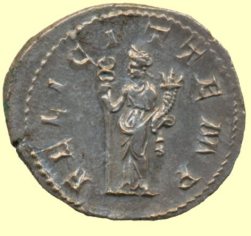

Felicitas is the Roman personification of good luck, happiness and prosperity. She was closely associated with the person of the emperor as she symbolized the blessings of his regime. Felicitas is first mentioned in Roman history when a temple was dedicated to her by Lucius Licinius Lucullus who was consul in 150 B.C. not to be mistaken for his famous grandson of Plutarch's biography. To built the temple he used booty from his campaign in Spain in 150-151 B.C. it was dedicated by him in 146 B.C. It was burned down early in the reign of Claudius and apparently not rebuilt. Another temple to Felicitas was planned by Julius Caesar in 44 B.C. he demolished the Curia Hostilia for this purpose but he was assassinated before the temple was finished. The work was picked up by Marcus Aemilius Lepidus who finished the temple. Nothing is known about the later history of this temple. Festivals of Felicitas were held on the 17th of January and on the 9th of October.


Felicitas is represented on coins draped, holding a a caduceus (as a sign of peace and concord) and a cornucopia (symbolizing prosperity). Other symbols include a basket of fruit, a globe, a palm-branch and a patera. Common inscriptions on coins are FELICITAS AVG (happiness/prosperity of the emperor) FELICITAS REIPVBLICE (happiness/prosperity of the state) FELICIT TEMP (Felicitas Temporum , happiness/prosperity of the times).